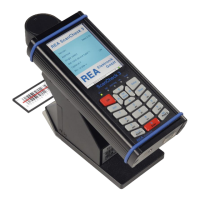Automation
Electronic Devices and Systems
4.1.1 Instructions for Correct Execution of Code Evaluations
The following procedures must generally be observed when evaluating bar codes so that comparable
and repeatable measurement results are obtained:
1. The laser beam must cross the bar code bars at an angle of 90°.
If this is not the case, the unit indicates bar code sizes incorrectly.
2. The bar code sample must lie flat and even in front of the verification unit. If this is not the
case, the contrast results change. Metallic and glossy materials are particularly critical.
3. The distance to the bar code sample must always remain the same. The ideal distance is
when the REA ScanCheck 3 is in front of the calibration code, exactly as on the calibration card.
4. There should be a free region of about 30 cm in front of the REA ScanCheck.
If there is a bright/dark wall in this region, for example, the contrast results will change.
5. If the ambient light changes, a recalibration must be carried out.
Light changes from light with high ratios of red light/infrared light to light types with low ratios of
red/infrared (e.g. changing from daylight to neon light) are critical.
6. Measurements in direct sunlight are to be avoided because the measurements are falsified.
7. The bar code to be verified should be located centered in front of the REA ScanCheck 3, in
order to obtain the best measurement accuracy (see the positioning help on the calibration card).
8. If there is more than one code in the scanning beam region, then the first code is registered
and measured from the left side by default. It can thus be necessary to cover other codes in
order to be able to center the code to be verified in front of the REA ScanCheck 3.
9. The REA ScanCheck 3n may never be calibrated with extension plates installed, because the
calibration is falsified by the cut-outs in the plates.

